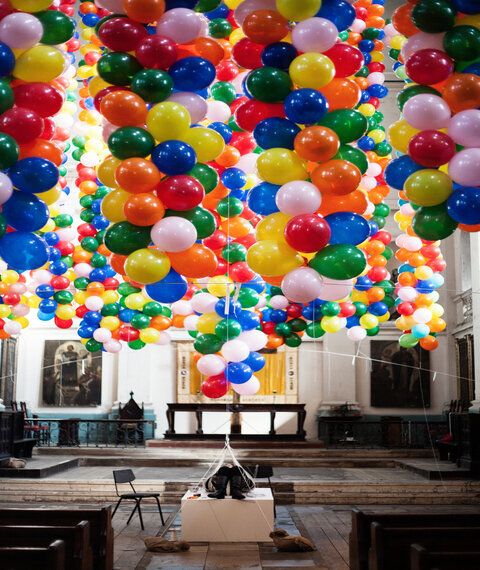
Noemi Lakmaier's 'Cherophobia', Southbank Centre's Unlimited Festival 2016
Photo by Grace Gelder for Unlimited
On 3rd September artist Naomi Lakmaier floated in the main Sydney Opera House auditorium suspended from 20,000 helium balloons for nine hours in the restaging of a piece called Cherophobia, the fear of happiness.
During September and October, 6 artists will be finalizing research and development with their international counterparts: Baluji Shrivastav working with artists from India, Kaite O'Reilly with those in Singapore, Richard Butchins and Japan, Viva Carnival and Brazil, Billy Read and Hong Kong, and Rachel Gadsden with Palestine.
All the above are disabled artists funded by a programme called Unlimited of which I'm senior producer. It's a programme funded by Arts Council England, Arts Council of Wales, British Council and Spirit of 2012, delivered by Shape Arts and Artsadmin, and it recognises the leading role disabled artists from the UK hold internationally.
So why is the UK currently seen as leading the world? In part, its due to the place the arts held in the long history of social and civic struggle for equality and legislation. The role companies such as Graeae, Heart n Soul, Candoco Dance Company and Shape Arts played in that fight that's now being documented through the Heritage Lottery Fund (HLF) programme National Disability Arts Collection & Archive. It's also due to London 2012, and the commitment of the Cultural Olympiad to do for disabled artists what the Paralympics has done for disabled athletes. Unlimited is part of that wave, and it's not just us, check out the British Council's Disability Arts International and Disability Arts Online to name but two.
I always worry when anything is pronounced as 'leading the world'. There is an imperial implication there that's hard to swallow. Our 'success' is built on an unstable and inequitable history in which the UK has been complicit. But having travelled to many countries and seen much art by many disabled artists I can see why we have this label. Our artists are fierce and bold, ambitious and varied. There isn't just one type or style of work or artform, but many. Our stories are nuanced. Our skill levels are high. Or have been.
The question is can we keep that status? Unlimited is comparatively well funded - the arts sector has placed money into this seam of work, but still our global status is under serious threat.
Internationally, the British arts scene is squeezed - whatever your opinion on Brexit, it's costing us money, the visa situation has gone from bad to much, much worse (for example, threatening one of Unlimited's international collaborations since we can't obtain visas for Palestinian disabled artists to visit the UK) and British Council funds are being reduced.
Disabled artists are under another set of pressures in addition. The ongoing austerity agenda in the UK hasn't just bitten, its chewed up a generation. The move from DLA (Disability Living Allowance) to the unworkable PIP (Personal Independence Payments), new rules, regulations and caps at ATW (Access To Work) and most recently, a new DWP (Department for Work and Pensions) squeeze on Working Tax Credits and what counts as a viable income.
All the above are starting to dictate which disabled people can work as artists and which can't. This is fundamentally in opposition to the values we hold as a programme. We believe that any disabled person with talent and ambition has the right to both create work, and to have the access support they require to take that ambition as far as they can.
We live in a society where disability is still seen more frequently as a plot devise rather than simply part of the human condition (see autumn's new TV schedules with amputee Cormoran Strike in JK Rowling's Strike and acid-burned Gabriel Markham in Rellik). Where disability is most frequently acted rather than authentic (the above played by Tom Burke and Richard Dormer respectively, both non-disabled actors).
You can look at it from an equality perspective - disabled people should morally have the same opportunities and chances as their non-disabled peers, or you can look at it aesthetically - disabled artists can provide a new unique perspective and often, through the creativity imposed by access and alternative ways of being in the world, this can ripple out throughout the creative sector. Either way, we are an important part of the cultural ecology. And for us, that ecology is global - from disabled artists pushing technological boundaries, learning new skills in production or simply highlighting exceptional work that deserves a wide international audience
Before the onslaught of the heartbreaking devastation that has tragically struck the region, I had been due to travel to Mexico this week with artist Jo Bannon to speak at the Senate in Mexico City and Diverso Festival in Puebla. We had been asked to speak about the impact creativity can have on changing and reframing the way we view difference, diversity and disability as the UK is seen as a leader in this field. But for how much longer?
